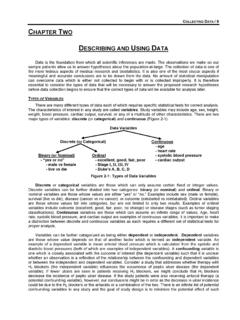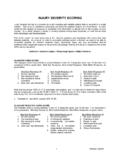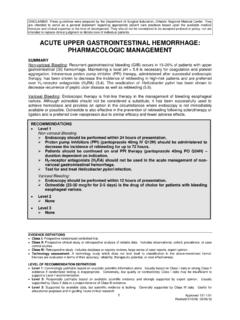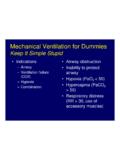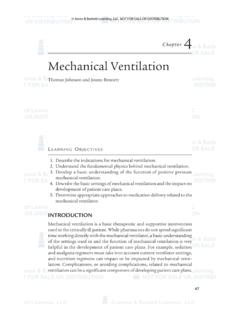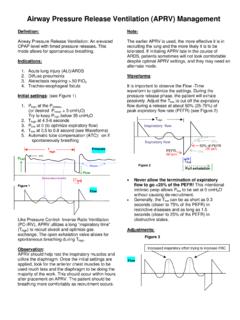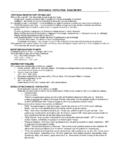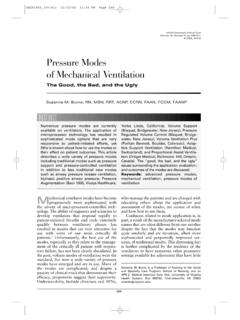Transcription of High frequency ventilation - SurgicalCriticalCare.net
1 DISCLAIMER: These guidelines were prepared by the Department of Surgical Education, Orlando Regional Medical Center. They are intended to serve as a general statement regarding appropriate patient care practices based upon the available medical literature and clinical expertise at the time of development. They should not be considered to be accepted protocol or policy, nor are intended to replace clinical judgment or dictate care of individual patients. EVIDENCE DEFINITIONS Class I: Prospective randomized controlled trial. Class II: Prospective clinical study or retrospective analysis of reliable data. Includes observational, cohort, prevalence, or case control studies. Class III: Retrospective study. Includes database or registry reviews, large series of case reports, expert opinion.
2 Technology assessment: A technology study which does not lend itself to classification in the above-mentioned format. Devices are evaluated in terms of their accuracy, reliability, therapeutic potential, or cost effectiveness. LEVEL OF RECOMMENDATION DEFINITIONS Level 1: Convincingly justifiable based on available scientific information alone. Usually based on Class I data or strong Class II evidence if randomized testing is inappropriate. Conversely, low quality or contradictory Class I data may be insufficient to support a Level I recommendation. Level 2: Reasonably justifiable based on available scientific evidence and strongly supported by expert opinion. Usually supported by Class II data or a preponderance of Class III evidence.
3 Level 3: Supported by available data, but scientific evidence is lacking. Generally supported by Class III data. Useful for educational purposes and in guiding future clinical research. 1 Approved 03/03/2009 THE USE OF HIGH frequency OSCILLATORY ventilation (HFOV) IN THE SURGICAL PATIENT SUMMARY High frequency oscillatory ventilation (HFOV) has emerged as an option for the treatment of patients with severe acute respiratory distress syndrome (ARDS). HFOV has been shown to be both safe and efficacious in improving oxygenation. The theoretical advantages of HFOV, however, have not yet translated clinically into improved outcomes when compared to conventional ventilation (CV) in the few trials published to-date.
4 INTRODUCTION Acute respiratory distress syndrome is a multi-factorial disease process that has a mortality rate of at least 30% (1). The mainstay of therapy is generally supportive mechanical ventilation . There is a significant decrease in lung compliance that often requires a considerable increase in ventilator settings. This increase in support often creates supranormal intrathoracic pressures. Recent literature has shown that these high pressures can induce additional lung injury known as ventilator induced lung injury (VILI) (1,2). This has prompted the search for alternative ventilation strategies that minimize VILI. VILI may occur by multiple mechanisms. Overpressure in the alveolar unit causes air leakage termed barotrauma.
5 Overdistension of the alveoli, termed volutrauma , causes both epithelial and endothelial damage. Repeated distension and collapse of the alveoli during the ventilatory cycle causes additional shear forces known as atelectrauma . Finally, this repetitive cycle of injury leads to the release of inflammatory mediators that can also lead to multi-organ failure on a systemic level (1,3). The properties of HFOV can, in theory, minimize these mechanisms of injury. This has made it an attractive option for these clinical situations. RECOMMENDATIONS Level 1 None Level 2 HFOV should be considered in patients with oxygenation failure (FiO2 , PEEP 15 cm H2O) refractory to conventional mechanical ventilation .
6 Level 3 Initial HFOV settings should include the following: mean airway pressure (Paw) 5 cm H2O above CV; FiO2 ; frequency 6 Hz; Inspiratory time 33%; Amplitude ( P) 90 cm H2O; Bias flow 40 L/min. Clinical indications include treatment for refractory oxygenation failure and refractory bronchopleural fistula. 2 Approved 03/03/2009 HFOV works by maintaining lung inflation at a constant elevated mean airway pressure (Paw) while using a piston to cycle the ventilation rate at several hundred times per minute. This results in a tidal volume that is often smaller than the anatomical dead space of the lungs.
7 Recent studies, the most prominent being by the ARDS Network group, have shown that lower tidal volumes help to reduce volutrauma injury to the lungs (4). The smaller tidal volumes of HFOV fit well with this concept. HFOV also functions to minimize the cycle of alveolar distension and collapse by maintaining airway pressures throughout ventilation . The rapid pressure changes created by the oscillating piston are attenuated at the alveolar level thereby minimizing atelectrauma and improving alveolar recruitment (3). This effect is also improved by the use of periodic recruitment maneuvers while on HFOV. All of these attributes of HFOV would seem to make it an attractive therapy for severe ARDS patients.
8 Unfortunately, the theoretical advantages of HFOV have not yet been proven in the clinical setting. Current literature shows that HFOV is safe and improves oxygenation in ARDS patients. Current controlled trials show promising trends, but have yet to demonstrate improved outcomes with the use of this therapy. LITERATURE REVIEW In 2000, the ARDS Network published a comparison between low tidal volume (6 mL/kg) ( lung protective ) and traditional tidal volume (12 mL/kg) ventilation . The result was a significant decrease in mortality in the low tidal volume group. While the optimal tidal volume strategy has not been determined, it is evident that there is certain pathology caused by over distention and collapse of alveoli during the respiratory cycle.
9 This disruption of the functional pulmonary unit results in both local and systemic inflammation further exacerbating hypoxemia and multi-organ failure (4). In addition, studies by Ranieri et al. showed a decrease in white blood cells and select inflammatory mediators in blood and alveolar lavage samples in patients ventilated using lung protective strategies (5). The largest of the two randomized controlled trials using HFOV in the adult population was published by Derdak et al. in 2002 (6). The purpose of this study was to evaluate the safety and efficacy of HFOV. One hundred forty-eight adult patients with ARDS were randomized to HFOV versus conventional ventilation (CV). The HFOV group was exposed to significantly higher Paw and showed a significant improvement in PaO2/FiO2 ratio over the first 16 hours.
10 This improvement, however, did not persist past 24 hours. Thirty day mortality was 37% in the HFOV patients and 52% in CV patients. This difference only trended towards significance (6,7). Of note, there was also a significant increase in pulmonary artery occlusion pressure (PAOP) and central venous pressure (CVP) measurements in the HFOV patients. There was no significant difference in complications during therapy. There was also an insignificant difference in total ventilator days (6). This paper concluded that HFOV is safe and efficacious in the adult population; however, the study was not powered to show a significant decrease in mortality. The only other randomized controlled trial was stopped prematurely secondary to enrollment issues.



